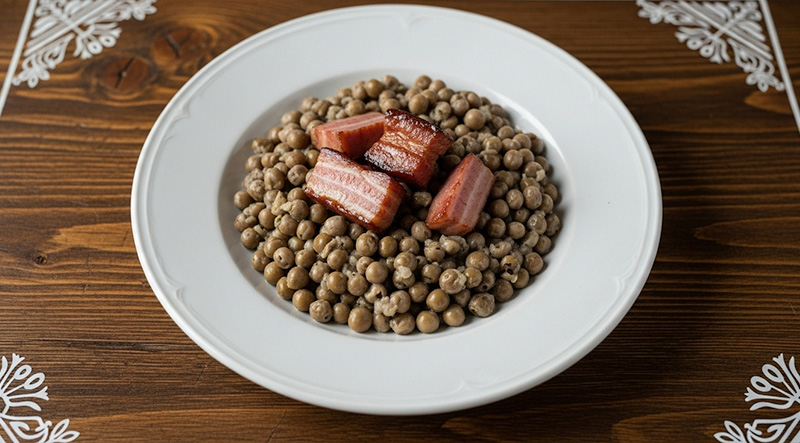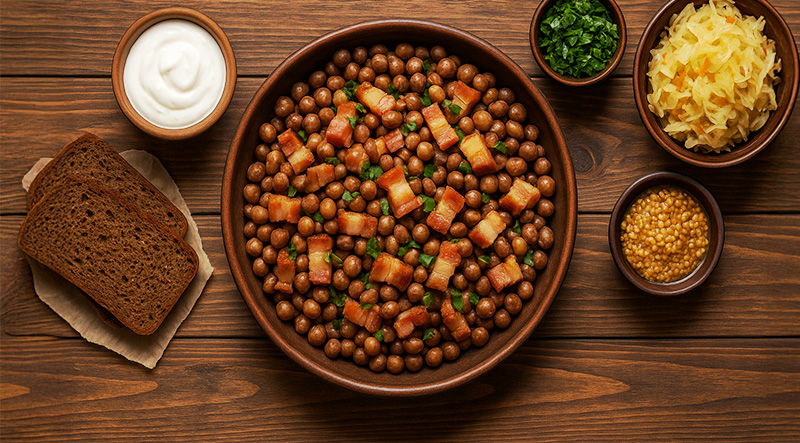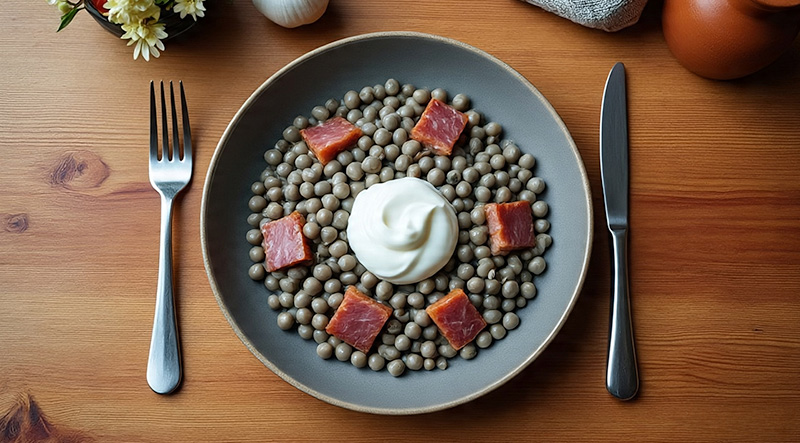Smoky, savory, and rich in tradition, **Grey Peas & Speck (Pelēkie Zirņi ar Speķi)** is a national treasure and the quintessential comfort food of Latvia. This filling dish combines crispy, golden **speck** (smoked pork fat or bacon) with earthy **grey peas**, a local legume prized for its creamy texture, to create a rich, rustic flavor that's hard to resist. This heartwarming favorite, which is typically consumed during the winter holidays, combines the best aspects of Latvia's farm-to-table heritage in a single, filling bite. Read More...
The History of Grey Peas & Speck (Pelēkie Zirņi ar Speķi) – Latvia’s Rustic National Dish:
In the windswept forests and fertile fields of Latvia, one dish has remained a comforting constant across centuries of history: Grey Peas & Speck, or Pelēkie Zirņi ar Speķi. This simple yet deeply satisfying combination of boiled grey peas and crispy speck (smoked pork fat or bacon) has long nourished the Latvian people through cold winters, festive celebrations, and times of hardship. Today, it is proudly recognized as Latvia’s national dish, a culinary emblem of resilience, tradition, and rural heritage.
A Peasant Dish with Deep Roots:
The story of Grey Peas & Speck begins in Latvia’s agrarian past, when self-sufficiency was not just a lifestyle, but a necessity. Grey peas—a hearty legume native to the region—were a reliable crop for Latvian farmers, thriving even in poor soil and storing well through the long, harsh winters. Known for their earthy flavor and firm texture, grey peas became a dietary staple, especially among the peasantry, who depended on dried goods to survive until the next harvest.
In a time when meat was a luxury, speck—rendered pork fat with bits of meat—offered an affordable and flavorful way to enrich simple foods. A small portion could add saltiness, smokiness, and satisfaction to otherwise plain meals. When combined, boiled grey peas and fried speck became a rustic but complete meal: high in protein, rich in flavor, and deeply nourishing.
A Holiday Favorite:
Though originally a dish of necessity, Grey Peas & Speck took on a special role in Latvian holiday traditions, particularly Ziemassvētki, the Latvian winter solstice and Christmas celebration. The dish became a symbol of good fortune and abundance, with families preparing it as part of the festive table spread.
A widely held belief in Latvian folklore is that eating grey peas at New Year’s ensures that tears will be few in the coming year—since the round shape of the peas represents tears, consuming them is said to “get them out of the way.” As such, Pelēkie Zirņi ar Speķi is as much a superstitious custom as it is a comforting food.
Humble Yet Respected:
Unlike many national dishes that are reserved for special occasions, Grey Peas & Speck remains a common everyday meal in Latvia. It’s easy to prepare, requires minimal ingredients, and reflects the core values of Latvian cuisine: practicality, seasonality, and respect for local ingredients.
The dish is also a reminder of the country’s resilience during Soviet occupation, when Latvians held tightly to their culinary and cultural identity through foods like this. Even when Western ingredients were scarce or restricted, grey peas and speck remained readily available and tied Latvians to their heritage.
Modern Revival:
Today, Grey Peas & Speck enjoys a revival in both home kitchens and high-end restaurants, celebrated not just as a nostalgic classic but as a proudly local delicacy. Chefs and foodies have embraced the dish for its authenticity and simplicity, often sourcing heritage varieties of grey peas and high-quality smoked pork to elevate the traditional recipe.
It is also featured prominently in culinary tourism, served to visitors as a taste of true Latvian comfort food. And with Latvia’s renewed emphasis on sustainable, local agriculture, this ancient dish finds itself perfectly in tune with modern food values.
A True Taste of Latvia:
Grey Peas & Speck is more than a national dish — it’s a living link to Latvia’s rural past, a symbol of cultural endurance, and a flavorful celebration of tradition. Whether eaten on a snowy winter evening, shared at a family holiday meal, or served in a modern bistro, this unpretentious combination of legumes and pork fat continues to warm hearts and bellies across generations. It’s proof that sometimes, the simplest foods leave the deepest impression.
Soak the Grey Peas:

Boil the Peas:
Fry the Speck:

Combine and Serve:
Optional Garnishes and Serving:

Tips:
In addition to soaking the peas overnight, the entire preparation and cooking time for Grey Peas & Speck is roughly one and a half to two hours. To soften and shorten the cooking time, the peas must be soaked for 8 to 12 hours in advance. Rinsing the peas, chopping the onions, and dicing the speck are all active preparation steps that take roughly ten to fifteen minutes. It takes 60 to 90 minutes to boil the soaked peas until they are tender, and 10 to 15 minutes to fry the onions and speck in a different pan. This is a fairly easy but time-consuming traditional dish that is served warm after both ingredients are ready.
According to the traditional recipe, one serving of Grey Peas & Speck (Pelēkie Zirņi ar Speķi) has roughly 350–450 calories. Grey peas, which provide 180–220 calories per serving and are high in complex carbohydrates and plant-based protein, provide the majority of the calories. About 150–200 calories are added by the bacon or speck, depending on the amount and fat-to-meat ratio, and another 20–30 calories are added by the onions and rendered fat. Although adding optional toppings like butter, herbs, or sour cream may slightly raise the calorie content, this dish is filling and substantial, making it ideal for comfort food in the winter months.



